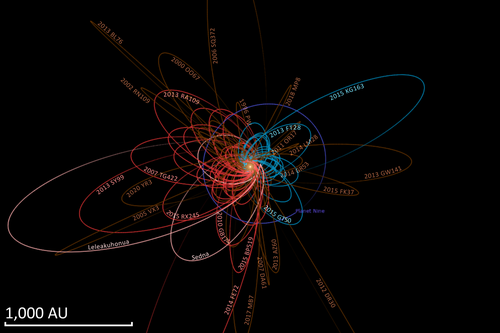

| Discovery[1][2] | |
|---|---|
| Discovered by | Mount Lemmon Srvy. |
| Discovery site | Mount Lemmon Obs. (first observed only) |
| Discovery date | 1 November 2005 |
| Designations | |
| 2005 VX3 | |
| TNO[3] · damocloid[4] unusual[5] · distant[1] | |
| Orbital characteristics[3] | |
| Epoch 27 April 2019 (JD 2458600.5) | |
| Uncertainty parameter4 | |
| Observation arc | 81 days |
| Aphelion | 1825.61 AU |
| Perihelion | 4.1058 AU |
| 914.86 AU | |
| Eccentricity | 0.9955 |
| 27,672 yr | |
| 0.1730° | |
| 0° 0m 0s / day | |
| Inclination | 112.22° |
| 255.35° | |
| 196.37° | |
| Jupiter MOID | 0.8884 AU |
| TJupiter | −0.9430 |
| Physical characteristics | |
| 7 km (est.)[4] | |
| 0.09 (assumed)[4] | |
| 14.1[1][3] | |
2005 VX3istrans-Neptunian object and retrograde damocloid on a highly eccentric, cometary-like orbit. It was first observed on 1 November 2005, by astronomers with the Mount Lemmon Survey at the Mount Lemmon Observatory in Arizona, United States. The unusual object measures approximately 7 kilometers (4 miles) in diameter.[4] It has the 3rd largest known heliocentric semi-major axis and aphelion.[6] Additionally its perihelion lies within the orbit of Jupiter, which means it also has the largest orbital eccentricity of any known minor planet.
2005 VX3 orbits the Sun at a distance of 4.1–1,826 AU once every 27,672 years (semi-major axis of 915 AU). Its orbit has an eccentricity of 0.9955 and an inclination of 112° with respect to the ecliptic. It belongs to the dynamical group of damocloids due to its retrograde orbit and its low Tisserand parameter (TJupiter of −0.9430).[3] It is a Jupiter-, Saturn-, Uranus-, and Neptune-crosser. The body's observation arc begins with its first observation by the Mount Lemmon Survey on 1 November 2005.[1]
| Orbital evolution — Barycentric elements | |||
| Year[7] (epoch) |
Aphelion | Semimajor-axis | Ref |
|---|---|---|---|
| 1950 | 2710 AU | n.a. | [a] |
| 2012 | 1914 AU | n.a. | [b] |
| 2015 | 2563 AU | n.a. | [c] |
| 2016 | 3235 AU | n.a. | [d] |
| 2050 | 2049 AU | 1026 AU | [a] |
2005 VX3 has a barycentric semi-major axis of ~1026 AU.[7][a] 2014 FE72 and 2012 DR30 have a larger barycentric semi-major axis. The epoch of January 2016 was when 2005 VX3 had its largest heliocentric semi-major axis.
The object has a short observation arc of 81 days and does not have a well constrained orbit.[3] It has not been observed since January 2006, when it came to perihelion, 4.1 AU from the Sun.[3] It may be a dormant comet that has not been seen outgassing. In the past it may have made closer approaches to the Sun that could have removed most near-surface volatiles. The current orbit crosses the ecliptic just inside Jupiter's orbit and has a Jupiter-MOID of 0.8 AU.[3]
In 2017, it had an apparent magnitude of ~28 and was 24 AU from the Sun. It comes to opposition in mid-June. It would require one of the largest telescopes in the world for any more follow-up observations.

|
| |
|---|---|
| TNO classes |
|
| Dwarf planets (moons) |
|
| Sednoids |
|